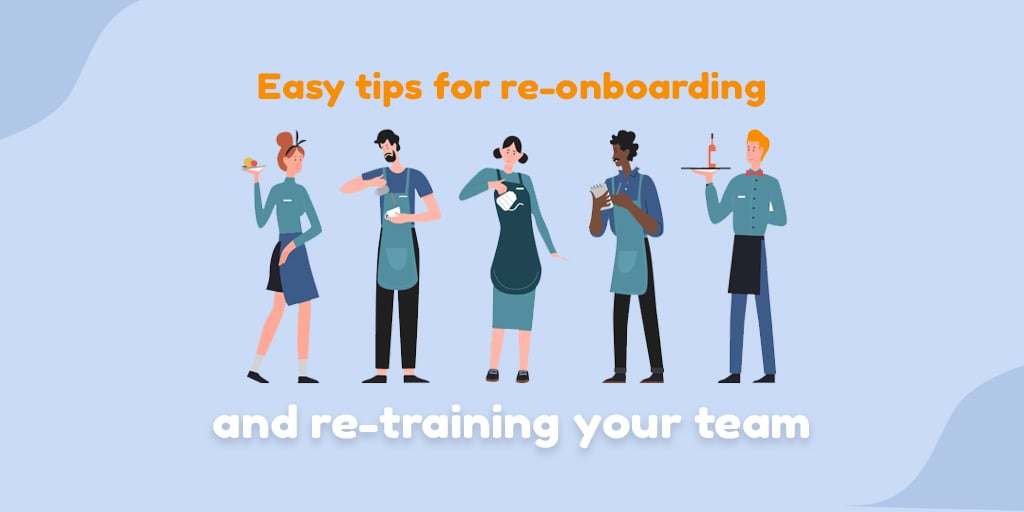Employee turnover is expensive. There’s no other way about it—SHRM (Society for Human Resource Management) reports that it costs approximately $4,700 to source, hire, and train a new candidate to the point that they are ready to work independently. If you’ve got even a little bit of turnover, you’re going to feel it in the hiring budget as much as you feel it in the workforce.
After all, if you can’t figure out how to keep employees from leaving, you’re going to keep feeling it. Not only that, but you’ll keep spending a small fortune on new hires that probably aren’t going to do much better because you’re not getting to the root of the problem. The first step in reducing employee turnover is to know why it’s happening. If you can’t pinpoint the cause, you won’t be able to come up with effective solutions.
In this guide, we’ll take a look at everything you need to know about how to reduce employee turnover, including what “reduced turnover” means, why it matters, and what you can do to boost retention and reduce the number of people leaving your organization for all reasons.
What Does Reduced Turnover Mean?
Reduced turnover means that you have fewer employees leaving the organization than you did before. Typically, it’s referring to the people being lost due to poor hiring practices or a lack of appropriate training, but the term “turnover” refers to the number of people who leave the organization within a specific time frame, such as each month or even each year.
If you reduce turnover, you reduce the number of people leaving your business for other opportunities or any number of other reasons. Several benefits come from reducing employee turnover, but the time and money involved are high on the list for most companies.
Why Is Employee Turnover Important?
Employee turnover is important because it tells you how many employees are leaving your company compared to how many are staying. It also tells you how quickly people leave the company, and how much it’s costing you to have these people coming and going all the time. Employee turnover can impact several aspects of the business. When you know who is coming and going, as well as how frequently those comings and goings are happening, it will be easier for you to improve retention and reduce turnover. Although turnover can be a learning opportunity for your business, consistent churn means that something bigger is going on and you need to address the issues at hand. Before we get into the details of how you can do that, let’s look at some of the benefits of reducing turnover.
Why Is It Important to Reduce Employee Turnover?
Companies want to reduce turnover, or stop people from leaving, to save money and streamline their business efforts. Fewer people coming and going will also mean more consistency and efficiency in all areas of the business. Because turnover can affect all the different areas listed above, it’s best to corral it and get a handle on the situation before it gets out of control.
The last thing you want is to be that company known for being a revolving door of employees—those companies are out there and you cannot be one of them. To avoid that, you need to figure out how to stop high employee turnover and improve employee retention.
Turnover costs upwards of $1 trillion to the U.S. economy each year. That can hit even the strongest businesses hard, which is why the goal is always to reduce employee turnover and boost retention. Some of the benefits of reduced turnover include:
· Lower operational costs
· Improved morale
· Increased productivity
· Better customer experience
· Better employee experience
· Increased efficiency in training and onboarding
· Improved culture
· Improved access to top talent
It’s about delivering a consistent experience for the customer every single time. The more employees you have that have been around for a long time, the easier that will be. Training and onboarding take a lot of time and effort and too many “newbies” can make even your most streamlined processes a scattered mess if you’re not careful.
Fortunately, for as many reasons as people leave jobs, there are equally as many strategies to help ensure that your people aren’t the ones who are leaving.
How to Reduce Employee Turnover: Effective Strategies to Add to Your List
As with any part of business, there are as many ways to reduce employee turnover as there are causes of it in the first place. What works for your organization may not be the same as what works for another. Having the right hiring process in the first place will ensure that your organization is attracting the right people, but there’s so much more that you can do.
For those trying to figure out how to keep employees from leaving, the list of strategies below is a good starting point. Think about how you can improve the hiring and onboarding process so that you’re getting the right talent in the first place. Then, consider how you can keep employees engaged and satisfied in their roles over time so that they are less likely to leave. Somewhere between competitive pay and benefits, employee recognition, and more flexibility, you’ll find plenty of people willing to stick around for the right reasons.
Perfect the Hiring Process
If you hire the right people, they’ll be less likely to leave. If you are struggling with turnover or just trying to make sure that it doesn’t become an issue, make sure that you go through your hiring process and make sure that everything is taken care of. Check the job listing and description for accuracy and make sure that you use keywords and phrases that will attract the right candidates.
Don’t hire bodies just to fill positions. Your company should have a screening and hiring process in place that ensures that you have the right people for the job, first and foremost. That way, you’re not going to lose people because they’re “not a good fit” or “not cut out for the position,” etc.
Equally important is to have a solid onboarding process that covers all the necessary areas of training and business information. It may take time to perfect, but your training and onboarding efforts should be focused on setting your people up for success both now and in the future.
Provide Employee Recognition
Employees who feel valued will stay with an organization longer than those who don’t. Recognizing your employees for their accomplishments and achievements will improve morale and company culture. It also supports your initiatives regarding diversity, equity, and inclusion, which are a big part of business today. This will also help build a community within the workplace and bring people together over shared accomplishments and celebrating various life events.
Social recognition is an investment that every business needs to make. It can increase engagement and productivity, boost the quality of work, and reduce turnover and absenteeism. Companies that offer social recognition programs will see increased job satisfaction, improved motivation, and improved employee retention.
Offer Competitive Salaries and Benefits Packages
Today, employees are demanding better pay and benefits from all employers. These are two main elements that help people choose jobs and decide to change those jobs. Higher pay and better benefits are at the top of the list of what would keep people loyal to an employer. Make sure that you know what you should be paying different employees and that your compensation structure is competitive.
Consider the benefits and other compensation offered besides pay, too. If you offer fully-paid health insurance, for example, you’re going to stand out against a competitor that is similar but makes people pitch in for their insurance premiums. Don’t go broke on this, but make sure that you’re keeping things competitive and more importantly, paying people what they’re worth.
Monitor and Mitigate Toxic Employees
Toxic employees find their way into every workplace at one time or another. Make sure that you’re keeping an eye out for anyone who could harm your team’s morale and productivity. Whether they’ve been around for years or they somehow got through the rigorous hiring process and suddenly you realize they’re not going to work out, you need to make sure that you’re aware of these people and how to handle them. Some can be coached or developed into better employees, but most of the time, it might be necessary to make the hard choice to let someone go.
After all, no matter how “effective” someone might be at their job or how hard they work, they could be creating a cultural drain on your organization and they will ultimately do more harm than good. Get rid of the employees that are eventually going to become turnover now and you’ll enjoy fewer issues with toxic and negative employees in the future.
Offer More Flexibility
Everyone in the world has seen just how much we can do at home. The pandemic created a demand for the ultimate in flexible scheduling and working arrangements. Now, many companies arbitrarily return to the office and assume “normal operations” without even considering the perks of maintaining that flexibility and convenience for employees.
Companies that want to reduce turnover in 2023 will continue to offer flexible scheduling options, whether that be hybrid remote schedules or the option of work hours, or any other flex option. They will focus on hiring people to get the job done, not just to clock the hours, and that will allow them to embrace all the aspects of scheduling and workplace flexibility that will improve retention.
Monitor Employee Engagement
How engaged are your employees? This is a large part of how likely people are to stay with an organization. Higher engagement means lower turnover and vice versa. While many companies have worked hard to improve engagement in regard to emotional and social elements, few focused on engaging with the actual position and the company in their job role. Several factors influence employee engagement, but relationships with management are a big part of it.
Not all industries make it easy to inspire employees—there’s not much that’s inspirational about machining the same part for the same equipment time and again—that’s where you have to get creative. Use surveys and feedback to find out how you can leverage your employee engagement to help accomplish goals and improve turnover at the same time. Getting people engaged can make them feel more valued and thus, make them more likely to stick around.
Build a Strong Corporate Culture
Culture is a word that’s all over the working world right now—but it’s so much more than just a buzzword. Companies that have the best retention are those that have a strong culture that embraces employees, appreciates them, and promotes a culture of teamwork and productivity. Your corporate culture is going to make or break several areas of your business's success, including the employees that you keep.
You can do everything else right, including hiring people who are qualified for their positions. But, if you don’t have a good culture that’s inviting and engaging, you’re not going to keep those qualified candidates for very long. Many people looking for work today are searching for culture first, so make sure that yours is on point.
Provide Opportunities for Continuing Education and Development
Employees hate changing jobs almost as much as employers hate having to hire for the same position time and time again. Not just that, but when people were surveyed, they said they would gladly forego as much as 12% of their salary expectation if they were given more development and training opportunities in their jobs.
People are no longer satisfied with just going to work and coming home. They want to know that they’re contributing to something and that there’s more potential to their job than what they do now. They want you to suggest they go back to school, have them attend a professional training class, or even create learning and development opportunities for in-house transfers. Whatever it may be, make sure that you’re giving people as many opportunities as possible.
Promote Work-Life Balance
Employees today consider benefits and perks to be primary factors in choosing a job. One of those perks should be a strong work-life balance that allows people to live their lives and enjoy all the moments, utilizing flexible schedules, hybrid work models, and plenty of paid time off and vacation time. Some companies are switching to unlimited PTO models that are designed to promote a better balance, but you don’t have to go that route if you’re not ready for it.
Just make sure that you choose efforts that do promote the type of work-life balance you want your employees to have. Also, practice what you preach, and don’t sit around the office until 7 PM when you’ve sent everyone else home at 4. People want their own work-life balance, but they also want to see it practiced at the higher levels within the organization, so they know it’s a top-down initiative.
Prioritize Employee Happiness
Some executives looking for metrics might think that “happiness” is a little too fluffy to consider important, but the numbers backing it up don’t lie. When employees are more engaged, they are more effective. They are happier and feel more valued, and therefore are more likely to continue to contribute to the team. They won’t need or want to seek work elsewhere because they are appreciated where they are at.
You should make sure that you check in with employees regularly so that you can get an idea of where they stand and how they’re doing. This will also help you determine how you can go about creating a better environment for people in the future and which elements of your company’s culture may need a second glance before you set them in stone.
Standardize Performance Reviews
Standard processes will ensure that you have a way of getting accurate measurements. If you want to see how employees are doing, standardize the review process and make sure that everyone knows what is expected of them. That “annual performance review” model of decades past is no longer good enough. As many as 80% of employees that felt unmotivated or criticized after an ineffective review began searching for new work.
When you make the performance review process a collaborative and ongoing effort that everyone can be engaged in, you are helping improve relationships and connect people to their teams in a better way. You can align individual and company goals and help get a better gauge of process and performance among your employees. When you connect goals to metrics and management, it’s easier to monitor and improve things.
Be Transparent
Transparency is an admirable attribute of any business. Those who want to reduce employee turnover will need to embrace it and all that it has to offer. Communicate with employees and create an ongoing feedback culture where everyone is on the same page about how things are going and how people are doing in their roles. Consider town halls, one-on-one meetings, and other opportunities to engage with your employees in a transparent way that makes them feel valued and understand their role.
Being transparent will also afford you the chance to get more out of your employees. When people feel like they’re being informed and appreciated, they tend to give more than those who don’t. Employees who feel like they have a voice and an understanding of what’s going on will be more invested, which will lead to a reduction in turnover.
Analyze Current Trends to Identify Issues and Solutions
This could be one of the most valuable tips in this entire guide, which is why we saved it for last. Having the capability to collect and analyze data related to turnover is going to be a game changer. Real-time software tools will help you break down turnover by period, identify reasons for leaving, departmental issues, geographical factors, and so much more. These tools can help you gain valuable insights about your business and why people leave.
When you know why turnover is high, it’s easier to reduce it. It’s also easier to find better strategies to onboard and retain employees because you already know what isn’t working. You can use all kinds of metrics and data to learn where the hiring process is failing, or if it’s an issue after the hiring has occurred and people are left to their own devices to work in their new roles. In any case, using this information can help you improve your talent management strategy and reduce turnover in several different ways.
Reducing Turnover Starts with Turning Over a New Leaf
For most businesses, embracing the new world of work is still a work in progress. However, it’s not something that you have to do completely on your own. Between the tips and tools that are available today, organizations have everything they need to improve workplace conditions to reduce turnover and create a better talent pool within the organization. The strategies listed here are just a handful of the ones that you can find out there, so feel free to see what other ways you can reduce employee turnover in your organization.
Today, you may be interested in adding a cloud-based HR platform that will manage every step of the employee journey, from hiring to training and beyond. These platforms can integrate with the rest of your software, including CRMs and project management tools, and they can help you track performance and enable better retention by monitoring the ongoing efforts of the organization.
No matter how you go about it, you need to figure out what’s going on so that you can reduce employee turnover by addressing the specific issues that are plaguing your organization. This can help improve retention, employee satisfaction, and so much more.





